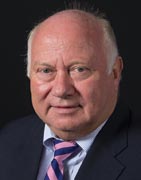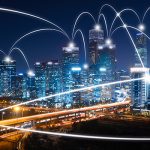 Prof. Dr. Günter Hein
Prof. Dr. Günter HeinA global navigation satellite system seems like such solid thing, like the pyramids, perhaps, or a mountain. Permanent, fixed, immutable.
Nor is this surprising. After all, GNSS distinguishes itself from many other technologies of the moment by its grounding in a large and widespread infrastructure: a master control station, launch facilities, far-flung monitoring stations, the space segment with dozens of massive satellites that can operate 20 years or more as did a recently retired GPS Block IIA spacecraft.
A global navigation satellite system seems like such solid thing, like the pyramids, perhaps, or a mountain. Permanent, fixed, immutable.
Nor is this surprising. After all, GNSS distinguishes itself from many other technologies of the moment by its grounding in a large and widespread infrastructure: a master control station, launch facilities, far-flung monitoring stations, the space segment with dozens of massive satellites that can operate 20 years or more as did a recently retired GPS Block IIA spacecraft.
From the user perspective, even those unaware of the tons of metal and electronics behind the signals their devices receive, the persistent and robust availability of the resource historically only adds to an expectation of continuity.
But that sense of unchanging permanence is deceptive. Indeed, a GNSS program is in constant motion, reaching for the future even as it secures its present with the labor and investments of the past.
Every GNSS program in existence today, including regional systems, is undergoing constant change — modernizing, evolving, expanding: the Global Positioning System with its GPS Block III program and next-generation operational control system, BeiDou moving from Phase II to Phase III as the system progresses toward a global presence, GLONASS working to bring new signals online with new satellites while completing a System of Differential Correction and Monitoring.
Even Europe, with only about a third of its initial Galileo space segment in place, began looking beyond its projected completion in 2020 with a formal GNSS “evolution” initiative launched in 2007. To gather more insight into how one GNSS program got out ahead of its inevitable modernization needs, we called on Prof. Dr. Günter Hein.
Hein was the head of the EGNOS and GNSS Evolution Department at the European Space Agency (ESA) from December 2008 until the end of 2014. He continues to organize the ESA/JRC International Summer School on GNSS, was appointed 2015 by the University FAF Munich as Emeritus of Excellence, and is now a member of the Executive Board of Munich Aerospace.
IGM: How far into the future is the current Galileo and EGNOS Evolution looking?
HEIN: Three years ago, the European Space Agency had already started within the GNSS Evolution Program a draft of the Galileo Second Generation (G2G) mission and system-level requirements, system architecture, and deployment scenarios (Phase A studies), as well as technology pre-developments. Considering that the first Galileo in-orbit validation (IOV) satellite launch took place in 2011 and taking into account a satellite reliability of 0.88 after 12 years in space, replenishment of the constellation has to be started after 2023.
Counting backwards and allocating sufficient time for the production of the satellites, the file supporting the decision for Galileo Evolution needs to be prepared over the next two to three years. This shows that there is not much margin left.
On the EGNOS side, the objective is to follow GPS signal modernization, and in particular the fact that the P/Y code tracking of GPS L2 will no longer be guaranteed in the long term. ESA will develop and qualify EGNOS V2.4.2 by the end of 2018, solving present hardware obsolescence and further improving LPV200 performance for civil aviation with respect to coverage and continuity.
The EGNOS second generation, called EGNOS V3, will augment GPS and Galileo on both L1/E1 and L5/E5a. New services will be introduced progressively in the first part of the 2020s. EGNOS V3 System Definition studies with two consortia have just been finished and V3 system test beds are established.
IGM: What are the key metrics/goals for improving Galileo and EGNOS performance through the Evolution program?
HEIN: The main goals for G2G are the resolution of shortcomings in the present system through “lessons learnt,” the implementation of potential, new functions or missions stemming from the evolution of the international GNSS environment in order to be competitive, emerging needs and/or opportunities offered by evolving technologies, and optimization of the exploitation efficiency of the system both in terms of cost and operability.
For that purpose, several options are under study, including optimization of G1G, an advanced payload on middle-Earth-orbit (MEO) satellites, a regional constellation incorporating inclined geo-synchronous orbit (IGSO) satellites with the MEO constellation, and inter-satellite links between MEO and/or IGSO satellites.
On the EGNOS V3 side the goal is to build up a dual-frequency, dual-constellation (GPS + Galileo) augmentation system with improved performance and new services (not only for aviation).
IGM: What possibilities are being considered for changes in the Galileo signal design and spectrum plan?
HEIN: For the Open Service L-band signals, in particular on E1, an enhancement of existing capabilities is being studied: faster time to first fix, enhanced robustness at the signal and message level, enhanced data delivery for challenging environments, and authentication. In addition, an improved accuracy is also planned taking advantage of a better clock and orbit modeling.
IGM: The Evolution program is investigating the possibility of inter-satellite links (ISL) for ranging and/or communications? What would the objectives be for introducing ISL and what factors appear to be most important in deciding whether to do so?
HEIN: Both objectives are being studied. One goal for inter-satellite links is coming from communication: investigating faster distribution of information in the Galileo system. Another goal would be the capability to improve the ranging among satellites and therefore produce improved orbit determination. One of the factors for a decision is the benefit versus the cost versus the number of satellites that would need to be equipped in order to benefit from ISL.
IGM: What non-navigation payload improvements are anticipated for the space vehicles’ physical design and capabilities?
HEIN: Most likely the G2G satellites will take advantage of a larger platform in order to increase their capabilities. At the same time, we want — as a minimum — to maintain the same launch cost efficiency. Therefore, the use of electrical propulsion is being studied not only for orbit changes — for example to change from one orbital plane to another — but also for the transfer from launch to the final orbit.
IGM: What are the prospects for integration of EGNOS into Galileo to create a unified constellation under one system operation?
HEIN: EGNOS like WAAS and other augmentations are guaranteed to be available for aviation until 2035. Regulations of most civil aviation authorities (CAA) require the control of augmentation signals and augmentations. This cannot be guaranteed by a single GNSS that is often under military control. Therefore, in the foreseeable future we will see that augmentation systems will increase and cover most of the Earth, say about 70 percent.
A change may come with Advanced Receiver Autonomous Integrity Monitoring (ARAIM) — still to be finally developed — but for the vertical requirements of aviation, this most likely will not occur before 2035. Thus, no real plans for the integration of EGNOS into Galileo exist besides the possibility of G2G to transmit EGNOS signals from IGSOs (inclined geosynchronous orbits) — a very low probability, however.
IGM: Is it possible that any of the evolutionary improvements might be included on the third-block purchase of FOC satellites to complete and sustain a 30-SV Galileo constellation?
HEIN: This has to be decided by the program manager, the European Commission, but the completion of the Galileo constellation as soon as possible is the clear program objective.




